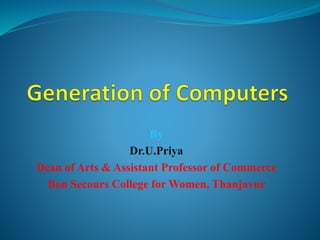
Generation of computers
- 1. By Dr.U.Priya Dean of Arts & Assistant Professor of Commerce Bon Secours College for Women, Thanjavur
- 2. Introduction Generation in computer terminology is a change in technology a computer is/was being used. Initially, the generation term was used to distinguish between varying hardware technologies. But nowadays, generation includes both hardware and software, which together make up an entire computer system. There are totally five computer generations known till date.
- 3. First Generation -1942-1954 First generation of computer started with using vacuum tubes as the basic components for memory and circuitry for CPU(Central Processing Unit). These tubes like electric bulbs produced a lot of heat and were prone to frequent fusing of the installations, therefore, were very expensive and could be afforded only by very large organizations. In this generation mainly batch processing operating system were used. In this generation Punched cards, Paper tape, Magnetic tape Input & Output device were used. There were Machine code and electric wired board languages used.
- 4. The main features of First Generation are: Vacuum tube technology Unreliable Supported Machine language only Very costly Generate lot of heat Slow Input / Output device Huge size Need of A.C. Non portable Consumed lot of electricity Some computer of this generation were: ENIAC EDVAC UNIVAC IBM- 701 IBM-650
- 5. Second Generation -1952-1964 This generation using the transistor were cheaper, consumed less power, more compact in size, more reliable and faster than the first generation machines made of vaccum tubes. In this generation, magnetic cores were used as primary memory and magnetic tape and magnetic disks as secondary storage devices. In this generation assembly language and high level programming language like FORTRAN, COBOL were used. There were Batch processing and Multiprogramming Operating system used.
- 6. The main features of Second Generation are: Use of transistors Reliable as compared to First generation computers Smaller size as compared to First generation computers Generate less heat as compared to First generation computers Consumed less electricity as compared to First generation computers Faster than first generation computers Still very costly A.C. needed Support machine and assmebly languages Some computer of this generation were: IBM 1620 IBM 7094 CDC 1604 CDC 3600 UNIVAC 1108
- 7. Third Generation -1964-1972 The third generation of computer is marked by the use of Integrated Circuits (IC's) in place of transistors. A single I.C has many transistors, resistors and capacitors along with the associated circuitry. The I.C was invented by Jack Kilby. This development made computers smaller in size, reliable and efficient. In this generation Remote processing, Time-sharing, Real-time, Multi-programming Operating System were used. High level language (FORTRAN-II TO IV, COBOL, PASCAL PL/1, BASIC, ALGOL-68 etc.) were used during this generation.
- 8. The main features of Third Generation are: IC used More reliable Smaller size Generate less heat Faster Lesser maintenance Still costly A.C needed Consumed lesser electricity Support high level language Some computer of this generation were: IBM-360 series Honeywell-6000 series PDP(Personal Data Processor) IBM-370/168 TDC-316
- 9. Fourth Generation -1972-1990 The fourth generation of computers is marked by the use of Very Large Scale Integrated (VLSI) circuits. VLSI circuits having about 5000 transistors and other circuit elements and their associated circuits on a single chip made it possible to have microcomputers of fourth generation. Fourth Generation computers became more powerful, compact, reliable, and affordable. As a result, it gave rise to personal computer (PC) revolution. In this generation Time sharing, Real time, Networks, Distributed Operating System were used. All the Higher level languages like C and C++, DBASE etc. were used in this generation.
- 10. The main features of Fourth Generation are: VLSI technology used Very cheap Portable and reliable Use of PC's Very small size Pipeline processing No A.C. needed Concept of internet was introduced Great developments in the fields of networks Computers became easily available Some computer of this generation were: DEC 10 STAR 1000 PDP 11 CRAY- 1(Super Computer) CRAY-X- MP(Super Computer)
- 11. Fifth Generation 1990-till date In the fifth generation, the VLSI technology became ULSI (Ultra Large Scale Integration) technology, resulting in the production of microprocessor chips having ten million electronic components. This generation is based on parallel processing hardware and AI (Artificial Intelligence) software. AI is an emerging branch in computer science, which interprets means and method of making computers think like human beings. All the Higher level languages like C and C++, Java, .Net etc. are used in this generation.
- 12. It includes: Robotics Neural networks Game Playing Development of expert systems to make decisions in real life situations. Natural language understanding and generation. ULSI technology Development of true artificial intelligence Development of Natural language processing Advancement in Parallel Processing Advancement in Superconductor technology More user friendly interfaces with multimedia features Availability of very powerful and compact computers at cheaper rates Some computer types of this generation are: Desktop Laptop NoteBook UltraBook